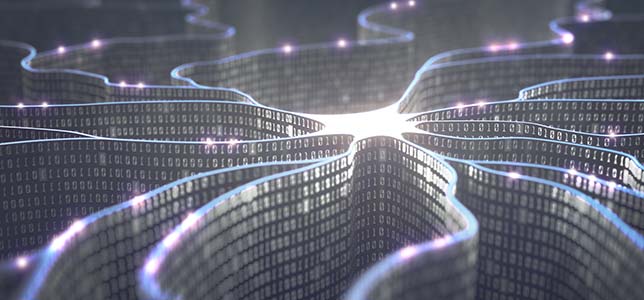AI, Merging of Digital and Physical Worlds Among Top 10 Tech Trends for 2018

Gartner has released its list of top 10 strategic technology trends for 2018 with a focus for the coming year on technologies related to artificial intelligence and machine learning and those that blend the physical and digital worlds.
"Gartner defines a strategic technology trend as one with substantial disruptive potential that is beginning to break out of an emerging state into broader impact and use, or which are rapidly growing trends with a high degree of volatility reaching tipping points over the next five years," according to a news release.
Gartner's first trend for next year is AI Foundation. The company predicts that the development of systems that learn and adapt and even function autonomously will remain a major battleground through 2020 at least.
"AI techniques are evolving rapidly and organizations will need to invest significantly in skills, processes and tools to successfully exploit these techniques and build AI-enhanced systems," said David Cearley, vice president and Gartner fellow, in a prepared statement. "Investment areas can include data preparation, integration, algorithm and training methodology selection, and model creation. Multiple constituencies including data scientists, developers and business process owners will need to work together."
Nearly every app and service will incorporate some level of AI in the next few years, according to the company, making intelligent apps and analytics the second trend to watch in the coming year. Whether they're obviously intelligent or use intelligence behind the scenes, these tools "create a new intelligent intermediary layer between people and systems and have the potential to transform the nature of work and the structure of the workplace," according to Gartner.
"Explore intelligent apps as a way of augmenting human activity and not simply as a way of replacing people," said Cearley in a prepared statement. "Augmented analytics is a particularly strategic growing area which uses machine learning to automate data preparation, insight discovery and insight sharing for a broad range of business users, operational workers and citizen data scientists."
Intelligent things, Gartner's third trend, rounds out the trends related to AI and machine learning. These tools, comprising everything from autonomous vehicles to connected industrial and consumer systems, are physical objects that incorporate AI to better interact with their surroundings or people.
Fourth on the company's list, digital twins are virtual representations of real-world objects or systems. Digital twins are linked to their real-world counterparts and useful for understanding them, responding to changes or otherwise improving operations or value.
"Over time, digital representations of virtually every aspect of our world will be connected dynamically with their real-world counterpart and with one another and infused with AI-based capabilities to enable advanced simulation, operation and analysis," said Cearley in a news release. "City planners, digital marketers, healthcare professionals and industrial planners will all benefit from this long-term shift to the integrated digital twin world."
The company's fifth trend, cloud to the edge, comprises a pair of technologies that some see as competing.
Edge computing places processing and content collection and delivery close to the source of information to reduce challenges related to latency, connectivity or bandwidth. Gartner suggests pairing this strategy with cloud computing to get the best of both technologies.
"When used as complementary concepts, cloud can be the style of computing used to create a service-oriented model and a centralized control and coordination structure with edge being used as a delivery style allowing for disconnected or distributed process execution of aspects of the cloud service," said Cearley in a prepared statement.
Conversational platforms will lead a "paradigm shift" in how humans relate to computers, according to Gartner, by moving the burden of understanding intent from people to technology. The company predicts that conversational interfaces will become a primary design goal delivered via dedicated hardware and as a core feature in operating systems, platforms and applications.
"Conversational platforms have reached a tipping point in terms of understanding language and basic user intent, but they still fall short," said Cearley in a news release. "The challenge that conversational platforms face is that users must communicate in a very structured way, and this is often a frustrating experience. A primary differentiator among conversational platforms will be the robustness of their conversational models and the application programming interface (API) and event models used to access, invoke and orchestrate third-party services to deliver complex outcomes."
The next trend, virtual, augmented and mixed reality, is currently in an "adolescent" and "fractured" state, according to the company, but may be implemented to help make employees more productive or improve training or visualization processes.
Currently used primarily as an infrastructure for digital currency, the next trend, blockchain technology, is growing into a platform for digital transformation, according to Gartner.
"Blockchain technologies offer a radical departure from the current centralized transaction and record-keeping mechanisms and can serve as a foundation of disruptive digital business for both established enterprises and startups," according to a news release. "Although the hype surrounding blockchains originally focused on the financial services industry, blockchains have many potential applications, including government, healthcare, manufacturing, media distribution, identity verification, title registry and supply chain. Although it holds long-term promise and will undoubtedly create disruption, blockchain promise outstrips blockchain reality, and many of the associated technologies are immature for the next two to three years."
The ninth trend highlighted by the company is the event-driven model, by which companies use tools such as the Internet-of-Things, cloud computing, AI and more to identify and analyze potential business events more quickly.
Continuous and adaptive risk and trust assessment (CARTA) rounds out the list.
"Security infrastructure must be adaptive everywhere," according to the company, "to embrace the opportunity — and manage the risks — that comes delivering security that moves at the speed of digital business."